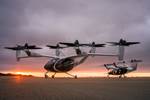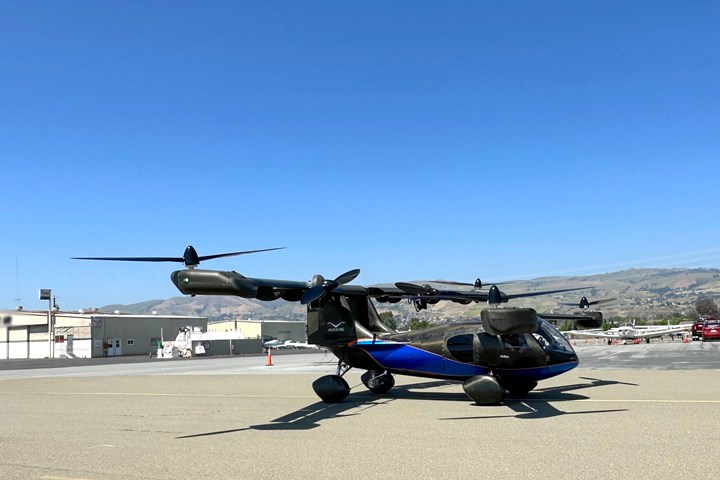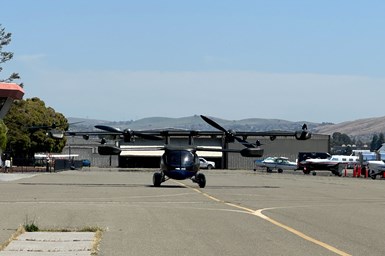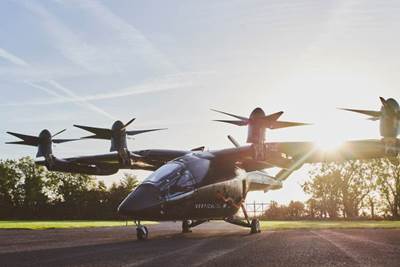Aska A5 drive-and-fly eVTOL progresses with FAA type certification
Composites-intensive four-seater prototype earns special airworthiness certification, takes next steps for its next technological milestone with in-progress flight and drive testing.
Share
Aska (Mountain View, Calif., U.S.) has announced that it has begun the type certification process with the Federal Aviation Administration (FAA) for the company’s four-seat electric vertical takeoff and landing (eVTOL) aircraft, Aska A5. Type certification signifies that the design is in compliance with applicable airworthiness, noise, fuel venting and exhaust emissions standards.
The Silicon Valley air mobility company’s prototype was awarded certificate of authorization (COA) and special airworthiness certification by the FAA and has started flight testing. Since 2022, Aska says it has performed successful ground testing and in Q1 2023 began conducting on-street driving tests. Special airworthiness certificate signals that Aska A5 has successfully met all FAA safety requirements.
Aska A5’s airframe, skin, wings and other components are made of composite materials, the company confirmed for CW. Aska boasts a complete composite airframe and parts manufacturing line at its facility in Mountain View, Calif., U.S.
“We have achieved a series of technological milestones in the first quarter of 2023 — debuting the first full-scale working prototype of the Aska A5 in January at CES, successfully performing field and driving tests and obtaining the COA and special airworthiness certification for our pre-production prototype,” says Guy Kaplinsky, CEO and cofounder of Aska. “The data we are harvesting from flight testing is enabling us to make progress towards our type certification. We already completed the initial phase and are progressing towards our next milestone, G-1 status.”
G-1 basis is a critical milestone in the FAA cross-validation process, establishing airworthiness and environmental requirements necessary to achieve FAA type certification validation.
The size of an SUV, the Aska A5 is a drive-and-fly eVTOL that can travel by road and air. The vehicle is said to be designed for the highest level of safety, a key factor that has enabled the company to make positive progress with the FAA toward type certification.
Aska A5 retains six independent motor systems for flight. It uses a dual hybrid energy supply, combining gas-powered flight with a range extender engine that charges batteries in-flight. Large aerodynamic wings are optimized for safe landing, with the ability to glide, and the aircraft includes a ballistic parachute. Its maximum flight range is 250 miles, with airspeed up to 150 miles per hours.
“One of the significant advantages of a roadworthy eVTOL, like the Aska A5 is that it does not require the modification or electrification of existing airports since it can maximize the use of today’s infrastructure, such as the many charging stations located around us,” Maki Kaplinsky, cofounder, chair and COO of Aska, explains. “We are working with local airports in the Bay Area to test and confirm our concept of operations — they open the gate, Aska A5 drives in as a car, drives/taxis to the helipad or runway, transforms into the flight mode and can take off.”
The vehicle can also perform an energy-efficient short takeoff from the runway using the in-wheel motors and thrust from the props. Importantly, Aska A5 makes use of existing infrastructure, such as parking, charging stations, airfields, helipads and runways, for a seamless integration into city and suburban landscapes. The vehicle fits in standard parking spaces, it can be charged at home and electric vehicle (EV) charging stations and the range extender engine runs on premium gasoline purchased at existing automotive gas stations.
Pre-order reservations launched in 2021 and the company has already secured $50 million in pre-orders.
Related Content
Plant tour: Joby Aviation, Marina, Calif., U.S.
As the advanced air mobility market begins to take shape, market leader Joby Aviation works to industrialize composites manufacturing for its first-generation, composites-intensive, all-electric air taxi.
Read MoreLilium launches M&A process, targets eVTOL program continuation
Despite court-approved insolvency filings and beginning first investor briefings, Lilium remains fully focused on re-emerging following restructuring, setting its sights on fresh investment to support the Lilium Jet.
Read MoreCollins Aerospace to lead COCOLIH2T project
Project for thermoplastic composite liquid hydrogen tanks aims for two demonstrators and TRL 4 by 2025.
Read MoreHonda begins production of 2025 CR-V e:FCEV with Type 4 hydrogen tanks in U.S.
Model includes new technologies produced at Performance Manufacturing Center (PMC) in Marysville, Ohio, which is part of Honda hydrogen business strategy that includes Class 8 trucks.
Read MoreRead Next
Joby marks production launch, receives permit to fly first eVTOL prototype
Joby has received a Special Airworthiness certificate for its first composites-intensive aircraft built at the company’s pilot production line built in close collaboration with Toyota, enabling flight testing to begin.
Read MoreVertical Aerospace announces Design Organisation Approval (DOA)
Issued by the U.K. Civil Aviation Authority (CAA), this marks a step toward Type Certification for the company’s VX4 eVTOL aircraft.
Read MorePlant tour: Daher Shap’in TechCenter and composites production plant, Saint-Aignan-de-Grandlieu, France
Co-located R&D and production advance OOA thermosets, thermoplastics, welding, recycling and digital technologies for faster processing and certification of lighter, more sustainable composites.
Read More



























